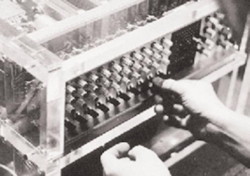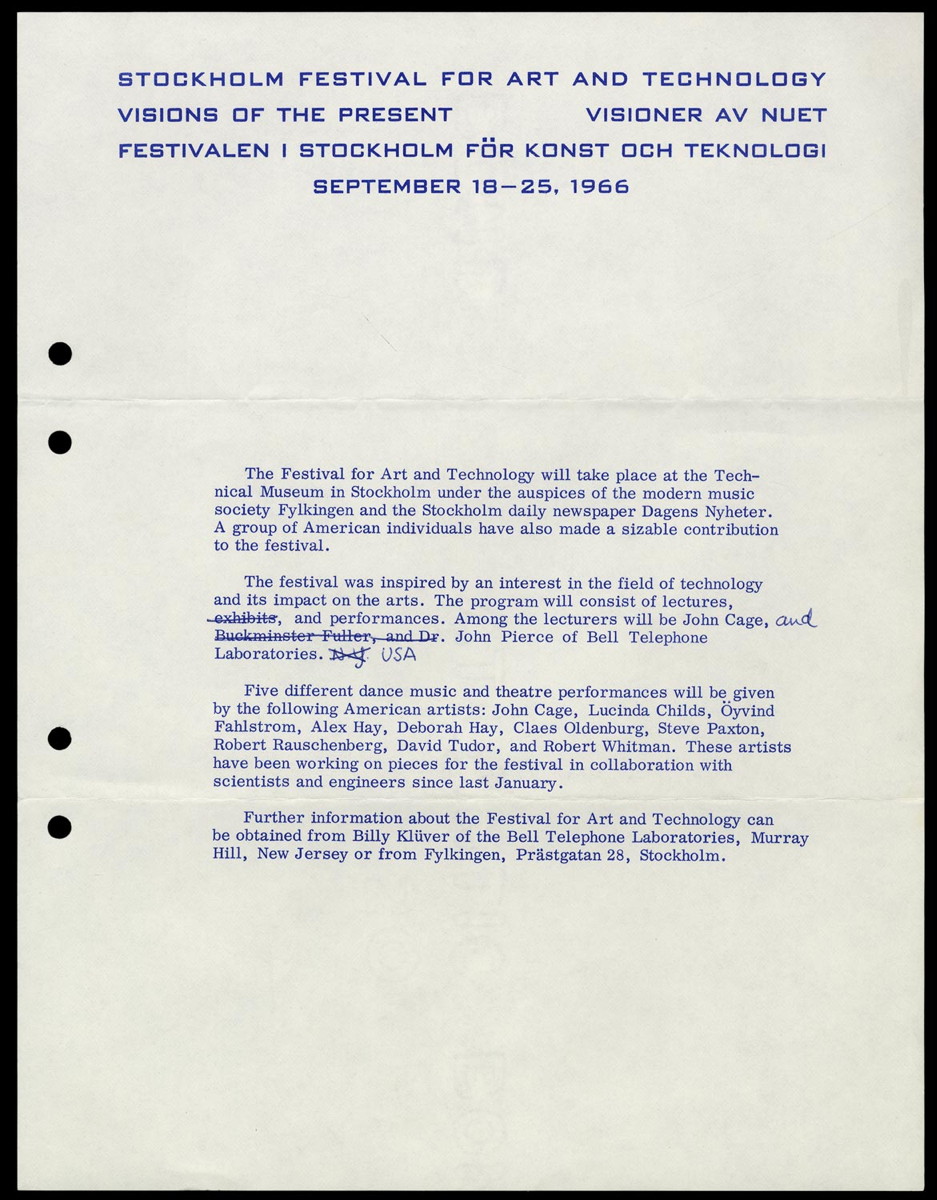18-25 sept 1966(Edit)
Visions of the Present / Visioner av Nuet
Organisation :(Edit)
Fylkingen Society for Experimental Art, Stockholm Festival on Art and Technology, Stockholm
Description :(Edit)
The festival was organized along various themes: Technology (teknik), Values (värderingar), Image (bild), Music (musik), Language (språk) and Environment Design (miljöskapande), and had a full schedule that began at 10 a.m. and ended with concerts at 8 p.m.
According to the program, the overall purpose of the festival was to, ‘sharpen our awareness of and use of all our senses and our imagination with the help of the latest technology and to share in the work of pinning down the reasons as to why we do not utilize these enormous technical resources in a more satisfactory way.’
Fylkingen originally was a concert union playing chamber music (started in the 30s). During the 1950s, Fylkingen gradually changed its repertoire to more modern pieces, later shifting its focus entirely to contemporary performance. In the beginning of the 1960s, Fylkingen’s focus shifted from merely presenting contemporary music to a more active attempt to participate in and influence various areas of musical life. In order to activate members, working groups were established. The theory group held a prominent position, since their topic of focus, art and technology, was the core of Fylkingen’s aims and activities. Lesche has explained the theory group’s work in these terms: ‘What the theory group could do is to see what kind of worldview and values lie behind the work, regardless of whether the artist has explicitly expressed them or not. [...] I imagine that the situation might arise of an artist putting his proposal to his group, but having diffi culties justifying the proposal. Then he could call on the theory group to help him formulate justifi cations and values. Similarly, the theory group could analyse the values behind the intuitively creative artist’s work.’ (‘Referat av Fylkingens Målsättningsdebatt’, Bilaga nr. 5, Fylkingens protokoll 15/3 1967, p. 2–3 [Fylkingens arkiv: F7]. Idébakgrund til konstnärlig manifestation 28/2/ 1966). Lesche’s idea of a neutral position, combined with an insistence on the focus on art, technology and knowledge, is also found in the contemporary Swedish reception to the English writer, social debater, and former scientist C.P. Snow’s (1905–1980) polemical essay "The Two Cultures", from 1959.
— Sanne Krogh Groth, "The Stockholm Festival, 1966", 2013.
Source : http://www.visionsofthenow.com/pdf/votn-sanne.pdf
The 1966 festival Visioner av Nuet was initiated by Knut Wiggen, Chairman of Fylkingen, and was originally called ‘Stockholm Festival for Art and Technology’. Knut Wiggen had involved the Swedish engineer Billy Klüver, who worked at Bell Telephone Laboratories in New Jersey, in the project of exploring how artists could use the ‘new technology’, and what would happen if artists and engineers collaborated. Billy Klüver coordinated new performances by the New York artists Robert Rauschenberg, John Cage, David Tudor, Yvonne Rainer, Deborah Hay, Robert Whitman, Steve Paxton, Alex Hay, Lucinda Childs and Öyvind Fahlström, who collaborated with a group of engineers from Bell Laboratories. The group worked together for months, preparing the performances for what in New York was referred to as ‘The Stockholm Thing’.
But after conflicts between Fylkingen and the Klüver group (mostly due to financial and some technical issues, but arguably also because of unresolvable differences in mindset) the American contribution was cancelled last minute, leading the Americans to organize their own event — what became the now-famous 9 Evenings of Theatre and Engineering, held at the 69th Regiment Armory in New York in October 1966.
In Sweden the festival took place as planned from 19–25th of September 1966, called Visioner av Nuet. Even though it had lost the majority of its artistic acts, making it more of a congress than a performance event, it included prominent speakers such as Iannis Xenakis, Yona Friedman, Sven Fagerberg and Kostas Axelos, and also showed art and music works by artists like Alvin Lucier, Karl-Birger Blomdahl, Ralph Lundsten, Åke Karlung and Nam June Paik.
Source : http://www.visionsofthenow.com/
Instead the event "9 Evenings: Theatre & Engineering" took place in New York on October 13–23, 1966, and "Visioner av Nuet" happened separately in Stockholm. Both events — and especially 9 Evenings — are now historically regarded as canonical, symbolising progressive thoughts on art and technology at the time.
Less remembered is that “9 Evenings” was supposed to have taken place in Stockholm and been called the Stockholm Festival for Art and Technology. The initiative was the idea of Knut Wiggen, the director of Fylkingen, an institution for electroacoustic music. Wiggen had involved Klüver, who in turn had invited Bell Labs engineers and New York artists. Large sums of money were raised, both in Sweden and in the United States. By the summer of 1966—as reported in an article by Fahlström, who was exhibiting at the Venice Biennale at the time—people everywhere were talking about “the Stockholm thing.” “New values are being created as a consequence of the rapid progress of technology,” wrote a reporter covering the festival. “Can humans be reeducated to get along with technology in a different and more positive way? The plan is to combine technical and artistic expressions to treat this problem, and see what happens.”
But after a conflict between Wiggen and Klüver, blamed on money issues and technical restrictions (but, more accurately, a consequence of irreconcilable differences in attitude and intentions), the collaboration broke down. The festival took place under the name “Visioner av Nuet” (Visions of the Now), without the Americans, in September 1966, and, consequently, consisted mostly of lectures and discussions; art and musical performances representing a much smaller part of the program than originally planned. Nam June Paik showed a “Robot”, as well as a large television piece, and Alvin Lucier attempted to control brainwave signals to create sounds in his “Music for Solo Performer.” Composer Iannis Xenakis and architect Yona Friedman were among the speakers, and topics ranged from “The Electronic Image” to “Technique of Living in the Future Society.” The most talked-about Swedish contribution was an audiovisual work called “Altisonans”, by Karl-Birger Blomdahl, who had been involved with the festival since the beginning.
— Anna Lundh, "The Tale of the Big Computer", 2010.
Source : http://canopycanopycanopy.com/13/the_tale_of_the_big_computer
Artists :(Edit)
Members of the seminar :
- Iannis Xenakis (architect and composer), Yona Friedman (Hungarian-born French architect), Sven Fagerberg, Kostas Axelos (Greek-French philosopher), Anthony Hill (visual artist), John R. Pierce (American scientist, Bell Laboratories), Ingmar Bengtsson (pianist and musicologist), Gunnar Fant (Speech Transmission Laboratory, KTH Royal Institute of Technology), Karl-Birger Blomdahl (composer), Carl Lesche (doctor of philosophy and psychoanalyst).
Topic of the seminar : In Sweden over 1,400 million kronor is being invested in scientifi c research and technological development. The result of these vast investments — which are increasing all the time — will infl uence and alter our external environment. This in turn will bring about a change in the way we see the world around us, in our perception of reality. If we are to keep external events under control, it is vital that we should be aware of such changes in reality. The investments being made to alter our external environment should therefore be followed up by investments which will make it possible to express this change in our perception of reality. One of the fi elds that could well become the object of investments to this end is that of the arts, the fi eld which is specifi cally concerned with needs, emotions, and evaluation. The aim of our symposium is to continue discussing the theoretical problems and artistic results of work in this field, to show what multichannel electronic sound reproduction and modern computer techniques can do as tools for the artist in his endeavours to express our changing reality. — (Dagens Nyheter, 29/4, 1966, translation found in Fylkingen Archives).
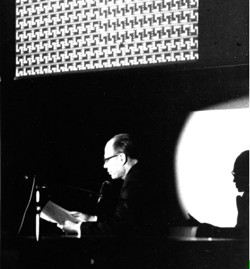
A lecture by John R. Pierce, director of Bell Laboratories Research-Communications Sciences division, at Visioner av Nuet, 1966.
Artworks :
- Alvin Lucier, Music for Solo Performer (1965)
- The sounds of the piece were controlled by alpha rhythms in the performer’s optic nerves. Electrodes were placed on the back of Lucier’s head, so that Lucier by opening and closing his eyes was able to control and perform the composition. From the loudspeakers sounded prerecorded modified brain waves, which corresponded to the thematic content of the piece. Some of the loudspeakers were also used in order to physically resonate percussion instruments placed on stage, so that acoustic sounds would accompany pre-recorded material from the loudspeakers.
- In a 1966 preparatory note for Variations VII, John Cage wrote to David Tudor that they should include sounds of brainwaves and a radio astronomy telescope, and that they "give credit to Lucier for brain and outer space." Alvin Lucier had already performed his "brainwave piece", Music for Solo Performer (1965) and Whistlers (1966), based on natural ionospheric and magnetopheric radio. For Lucier, both compositions used forms of "natural electromagnetic sound" and, in combination, they described a new type of spatial environment. Also, in 1966 the Swedish composer Karl-Birger Blomdahl created Altisonans, a nationally broadcasted television composition relating natural radio and satellite telemetry sounds to those of birds. These activities involved physicists, Rudy Kompfner, Billy Klüver, Edmond Dewan, Millett Morgan, and Ludwik Liszka to varying degrees, from non-cooperation to close collaboration. — Douglas Kahn, "1966: Natural Electromagnetic Sounds, From Brainwaves to Outer Space", STEIM Amsterdam, 2011
Source : http://www.dnk-amsterdam.com/index.cgi?dept=AGENDA&article=25 - "The idea for Music for Solo Performer (1965) came out of a series of conversations I had in 1964 with physicist Edmond Dewan of the Air Force Cambridge Research Laboratory in Bedford, Massachusetts. [...] Working long hours alone in the Brandeis University Electronic Music Studio with Dewan's equipment (two Tektronix Type 122 preamplifiers in series, one Model 330M Kronhite Bandpass Filter, which had been set for a range of from 9 to 15 Hz, one integrating threshold switch, electrodes, appropriate connectors, etc.) plus the studio's conventional equipment, I learned to produce alpha fairly consistently. I found that success could be attained by setting the gain on the audio amplifier to a point just below oscillation so that even a relatively weak alpha signal would come through. Often, I could produce alpha only in short bursts; it took precisely the right physical and psychological conditions to sustain it in longer phrases. I did not attempt any experiments in bio-feedback as such but was aware of the reinforcement of my own alpha-producing ability while monitoring in real-time the sounds that came out of the studio loudspeakers. I observed that over long periods of time, for example while recording alpha for storage material for use in performances, or when tired, relaxed, or slightly bored, the alpha would tend to drift somewhat downward and settle. From the beginning, I was determined to make a live performance work despite the delicate uncertainty of the equipment, difficult to handle even under controlled laboratory conditions. I realized the value of the EEG situation as a theater element and knew from experience that live sounds are more interesting than taped ones. I was also touched by the image of the immobile if not paralyzed human being who, be merely changing states of visual attention, can activate a large configuration of communication equipment with what appears to be power from a spiritual realm. I found the alpha's quiet thunder extremely beautiful and, instead of spoiling in by processing, chose to use it as an active force in the same way one uses the power of a river. I used the alpha to resonate a large battery of percussion instruments including cymbals, gongs, bass drums, timpani, and other resonant found objects. In most cases, it was necessary physically to couple the loudspeaker to the instrument, although in the case of highly resonant bass drums and timpani, the loudspeaker could be an inch or so away. Placing loudspeakers in trash cans or cardboard boxes worked extremely well as did using cheap small speakers face down on snare drums or taped against windows. I learned that by varying both short bursts and longer sustained phrases of alpha plus making musical decisions as to placement of loudspeakers, choice of resonant instruments of objects, volume control, channeling and mixing, I was able to get a wide variety of sonorities as well as retain the natural physical quality that seemed asked for by the sound source itself. In conjunction with the threshold switch, I used the alpha as a control signal to operate a stereo tape recorder upon which was stored transposed versions of pre-recorded alpha accelerated up to five times. These higher phantoms relieved the sameness of the low-frequency originals and were used both by themselves and to impart contrasting resonances to whatever instruments they were coupled to. My original intention was to develop the idea of control to include more sophisticated systems of lights, alarms, television sets, radios, whole environments. Although an assistant is usually needed to operate the preamplifier controls, I did perform "Music for Solo Performer" by myself on the “Visions of the Present” festival in Stockholm in 1966. I succeeded in producing alpha by letting my hands operate the amplifier controls as randomly as possible to avoid visualization caused by decision-making with reference to channeling and placement of loudspeakers. I have always wanted to have a situation in which the alpha could perform all the control functions by means of a code; for example, a certain number of bursts of certain durations could trigger certain mixtures of channels. "Music for Solo Performer" is dedicated to John Cage who assisted me in the first performance on May 5, 1965 at the Rose Art Museum, Brandeis University and to whom I am grateful for encouragement greatly appreciated at that time as well as now." — (Alvin Lucier, concert programme, Friday, September 15, 2006, Old Cabell Hall, University of Virginia)
Source : http://www.virginia.edu/music/archives/pressrelease/06-07/programs/lucier091506.pdf
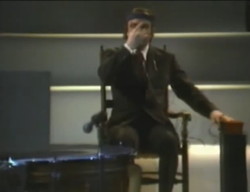
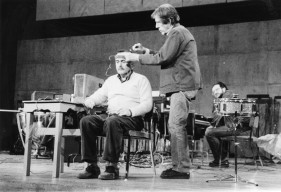
Alvin Lucier, Music for Solo Performer, 1965
- Karl-Birger Blomdahl, Altisonans (for electroacoustic instrument / or a vocal piece with electronics / or a musique concrète piece featuring bird songs)
- "Altisonans" drew together recorded bird vocalizations with sounds from space satellites and magnetic storms, testing a theory from physicist Ludvik Liszka [sic] that the song of the Redwing bears a remarkable similarity to that of some satellites' radio emissions.
- ‘There is, therefore, a natural melodious bird work down here on earth and an artifi cial one severalhundred miles or more out in space,’ Blomdahl writes in the program statement (1966). With the use of recorded birdsong, sounds from satellites and from magnetic storms occurring from the sun (both registered at an observatory in Kiruna, in the north of Sweden), the two worlds are contrasted, combined and brought into dialogue within the composition. The visual material is also based on registers from Kiruna, modified in a television studio.
- Initially "Altisonans" was accompanied by a film, being defined in the liner notes as a "bild-ljud-komposition", which in English means "image-sound-composition". It was premiered on Swedish Television 25 September, 1966. Pioneering Swedish experimental composer Karl-Birger Blomdahl made this television program entirely of radiation signals and collage imagery after meeting Polish geocosmophysicist Ludwig Wikliszka [sic], who introduced him to sounds sent back to earth by various satellites.
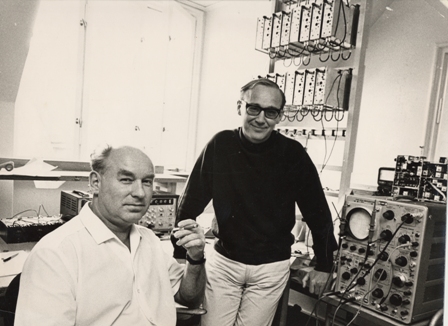
Karl-Birger Blomdahl & Knut Wiggen, 1966
Source : http://otherfilm.org/altisonans/
http://www.england-in-particular.info/cg/confluence/c-n07-01.html
- Ralph Lundsten, EMS NR 1
- (Premiered at Visioner av Nuet, 1966) Screening: 16 mm film with sound
- In the mid sixties Ralph Lundsten collaborated with a Finnish engineer, Erkki Kuriniemi, and built what probably was the worlds first polyphonic synthesizer with a sequencer. The Andromatic [pictured below]. It had 10 tone generators, some filters, and modulators. All analog. Erkki also built the Dimi-O in 1970 or 71. A synth with a tv camera where you played the music in the air,so to speak. This instruments made it possible to experiment vith interactive video techniques. He also built the Dimi-S. Dimi-S or "Sexophone" (Ralph Lundsten refers to this as the "Lovemachine") was a fun instrument for four players. Handcuffs and wires connected the players to the electronic unit, which measured the electrical resistance between all six pairs. When two people touched each other repeatedly, a sequence of musical tones were heard. With increasing skin moisture and contact area, the intensity of the music increased.
- Source : http://www.filmfreaks.nl/reel23/AA-04E-DIMI-.pdf (Andromatic)
http://www.matrixsynth.com/2006/07/ralph-lundsten-worlds-first-polyphonic.html
- Åke Karlung
- Nam June Paik,
- Robot
- and a installation consisting of televisions showing compositions based on the principle that, ‘scanning pattern, the path of the electron beam, is altered, regardless of whether any video-signal is fed in or not.’
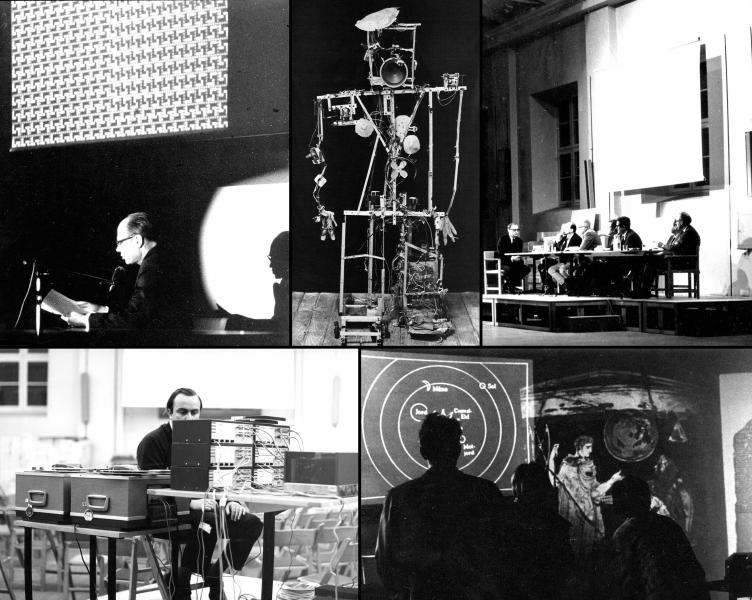
Sources, Urls :(Edit)
- http://www.visionsofthenow.com/ — [Retrieved on 6 nov 2013]
- http://www.visionsofthenow.com/pdf/votn-sanne.pdf — [Retrieved on 6 nov 2013]
- http://canopycanopycanopy.com/13/the_tale_of_the_big_computer — [Retrieved on 6 nov 2013]
- http://www.squidproject.net/contributions/49.htm — [Retrieved on 6 nov 2013]
Powered by LionWiki 3.2.5 — Thanks to Adam Zivner — Any material is under copyleft © with in-line & in-text attributions — Hosted by nujus.net NYC

